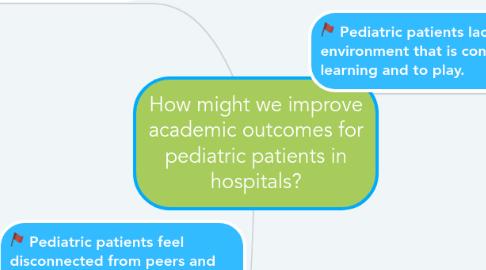
1. Pediatric patients lack an environment that is conducive to learning and to play.
1.1. Create a safe space and learning environment
1.1.1. Kids in the hospital are often scared and uncomfortable. We need to create a safe, calm learning environment that is accessible to bedside patients. No medical personnel should be in attendance while schooling is happening
1.1.1.1. as individual health circumstances allow
1.1.2. Cooperate with schools to arrange skype or facetime sessions with peers to bridge the gap between the hospital and schooling environments
1.1.2.1. Skyping with their old class will help kids feel less isolated and more involved in their learning! Arrange weekly skype or facetime sessions
1.1.3. Having parents present (if possible) to help increase motivation in patients
1.1.3.1. Parents need to be involved in learning in order to encourage children, it may be helpful to have parents present while child is doing schoolwork
2. Pediatric patients feel disconnected from peers and lack sense of school community.
2.1. Connect
2.1.1. Volunteer program with peers/teachers (in person, lesson plan) have a teacher going back and forth from hospital to school
2.1.1.1. It would be very helpful for kids to have a teacher from their home school who goes back and forth and coordinates lesson plans, etc, instead of having two teachers who coordinate between the hospital and the school
2.1.2. Partner with high schools so that their CALM/religion/leadership classes can get their required volunteer hours by helping keep patients up to date with their education
2.1.3. Coordinate with patient’s peers to come visit them at the hospital for social inclusion
2.1.3.1. Finally, coordinate visits from the child’s peers to the hospital. This can be a friend from the child’s old class who comes to help with homework and just give a general update on how the class is doing.
3. Coursework for pediatric patients is often disorganized and different from what their peers are learning.
3.1. Coordinate with teachers and health care team
3.1.1. Construct an individualized plan for each patient fitting with their daily routine illustrating when their education will take place and ensure each healthcare member has a copy
3.1.1.1. Schooling schedules need to fit in with the rest of the patient’s daily routine. Create an individualized plan for each patient stating when education is going to take place, and make sure each member of the child’s healthcare team has a copy of this plan
3.1.2. Collaborate with each patient and the members of their healthcare team along with the patient’s family and teachers
3.1.3. Design a discharge plan stating the patient’s educational progress to ease the transition back to school
3.1.3.1. A discharge plan stating what the child has learned while in hospital is important so that teachers at the child’s home school know where they’re at. When the child leaves the hospital their old teacher will know exactly what they need to learn to catch up.
